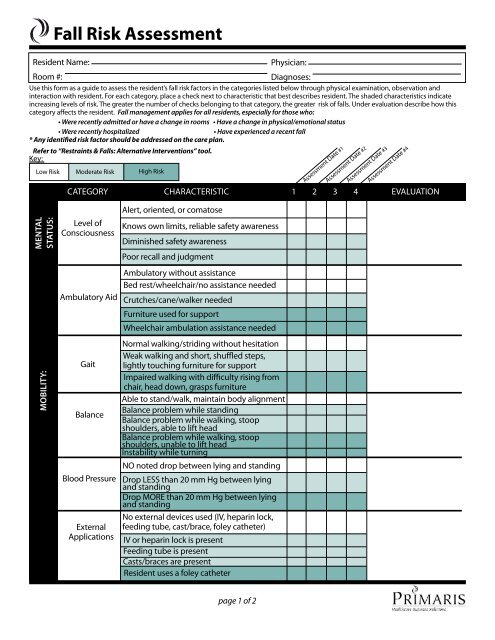Little Known Questions About Dementia Fall Risk.
Little Known Questions About Dementia Fall Risk.
Blog Article
How Dementia Fall Risk can Save You Time, Stress, and Money.
Table of ContentsHow Dementia Fall Risk can Save You Time, Stress, and Money.Things about Dementia Fall RiskThe Basic Principles Of Dementia Fall Risk Some Known Factual Statements About Dementia Fall Risk Fascination About Dementia Fall Risk
The FRAT has 3 areas: drop danger condition, risk variable list, and activity strategy. A Loss Risk Condition consists of information about history of recent drops, medications, psychological and cognitive standing of the individual - Dementia Fall Risk.If the client ratings on a danger factor, the corresponding number of factors are counted to the client's fall threat score in the box to the much. If a person's autumn risk rating totals five or greater, the person is at high risk for drops. If the client ratings only four factors or reduced, they are still at some risk of falling, and the nurse needs to utilize their ideal clinical assessment to manage all autumn threat elements as part of a holistic care plan.
These conventional strategies, in general, help develop a safe atmosphere that decreases unintended falls and delineates core precautionary measures for all patients. Indications are essential for individuals at risk for falls.
All about Dementia Fall Risk
Wristbands should consist of the client's last and initial name, day of birth, and NHS number in the UK. Information should be printed/written in black against a white history. Just red color needs to be utilized to signify unique person condition. These suggestions are constant with present growths in person recognition (Sevdalis et al., 2009).
Things that are also far might require the patient to reach out or ambulate needlessly and can potentially be a hazard or add to drops. Helps protect against the person from heading out of bed with no help. Registered nurses reply to fallers' phone call lights much more promptly than they do to lights started by non-fallers.
Visual problems can greatly create drops. Hip pads, when put on properly, may minimize a hip fracture when autumn occurs. Maintaining the beds closer to the flooring minimizes the risk of falls and major injury. Positioning the bed mattress on the flooring significantly lowers fall risk in some healthcare settings. Low beds are designed to minimize the distance a client drops after moving out of bed.
The Main Principles Of Dementia Fall Risk
Clients who are high and with weak leg muscular tissues who try to remain on the bed from a standing position are most likely to fall onto the bed because it's also reduced for them to lower themselves securely. If a tall person attempts to get up from a low bed without assistance, the individual is likely to drop back down onto the bed or miss the bed and drop onto the floor.
They're designed to advertise prompt rescue, not to prevent drops from bed. Apart from bed alarms, boosted supervision for high-risk people likewise may aid prevent drops.

Clients with an evasion gait boost autumn chances drastically. To minimize loss threat, footwear need to be with a little to no heel, slim soles with slip-resistant tread, and support the ankle joints.
Indicators on Dementia Fall Risk You Need To Know
In a study, homes with sufficient lights record less falls (Ramulu et al., 2021). Improvement in illumination at home may lower loss prices in older adults.

Sitters are effective for assuring a protected, protected, and secure atmosphere. Researches demonstrated extremely low-certainty evidence that sitters decrease autumn danger in severe care medical facilities and just moderate-certainty that choices like video monitoring can minimize sitter use without boosting loss risk, suggesting that caretakers are not as useful as initially believed (Greely et al., 2020).
The Of Dementia Fall Risk

Increased physical conditioning reduces the threat for drops and limits injury that is endured when fall takes place. Land and water-based exercise programs may be in a similar way valuable on equilibrium and gait and consequently decrease the danger for drops. Water workout may contribute a positive advantage on balance and gait for women 65 years and older.
Chair Increase Exercise Going Here is a simple sit-to-stand exercise that aids reinforce the muscles in the thighs and buttocks and boosts mobility and freedom. The objective is to do Chair Surge workouts without making use of hands as the customer comes to be more powerful. See resources section for a thorough guideline on exactly how to execute Chair Surge workout.
Report this page